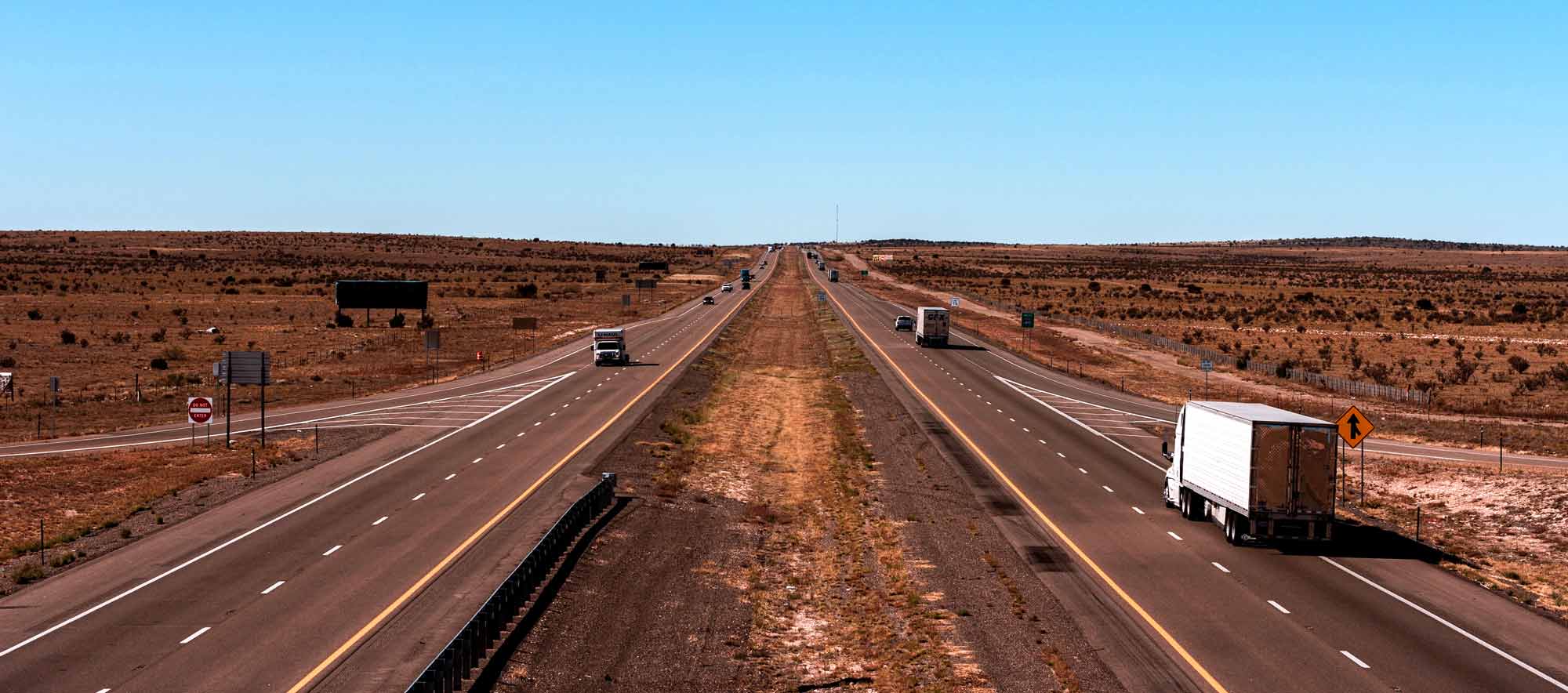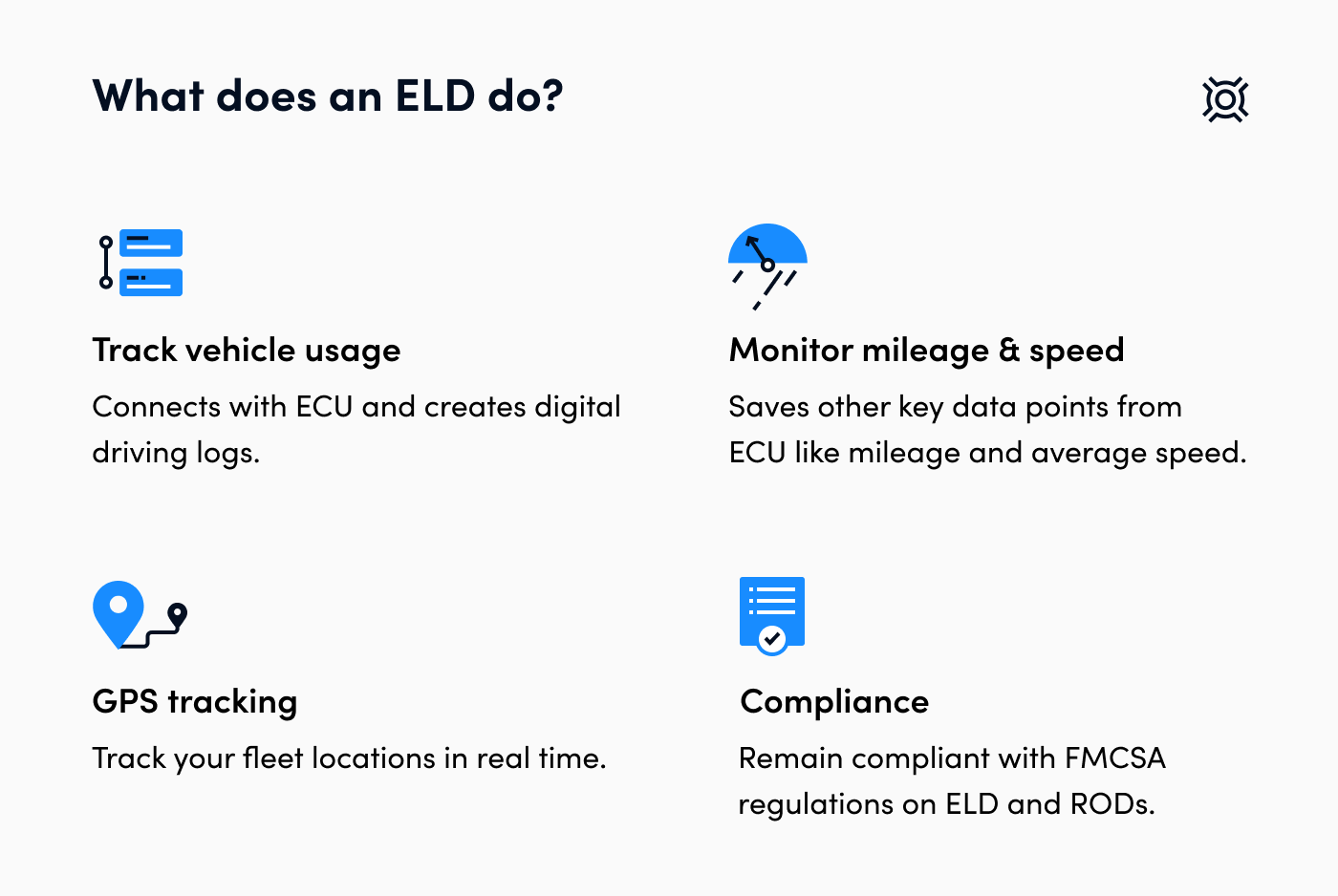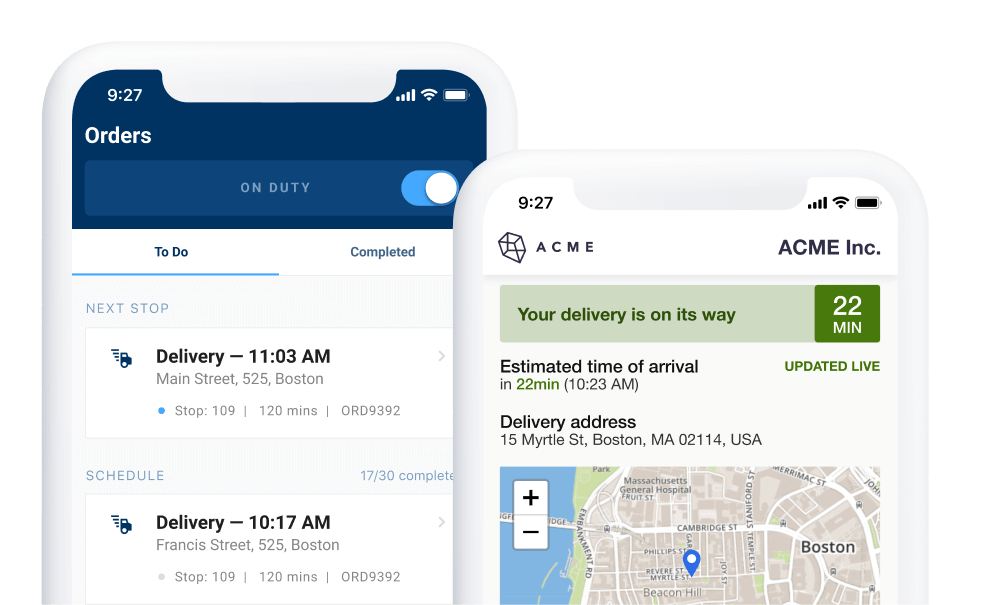ELDs: Do You Need Electronic Logging Devices for Your Fleet?
6 min read

The average long-haul trucker in the United States drives over 100,000 miles per year.
With strict hours of service (HoS) regulations, manually tracking how they follow the mandated 70 hours a week can be a time suck for drivers, dispatchers, and managers.
With ELD-tracking set up, you can make sure you know exactly where your fleet of truck drivers are at all times and make sure your company and drivers are following all required trucking regulations (avoiding fines of between $1,045 – $26,126 per vehicle and keeping your CSA score low).
In this article, we’ll cover what an ELD is, what it does, the ELD mandate, whether you need to use one, and more.
To jump to the topic which interests you most, click the links below:
- What Is an ELD (Electronic Logging Device)?
- What Does an ELD Do?
- The Benefits of Using ELD
- The ELD Mandate: Who Needs an ELD?
- OptimoRoute and ELDs: A Cost-Saving Combo
- Most Common ELD FAQs
What Is an ELD (Electronic Logging Device)?
An ELD system is designed primarily to track driving hours reliably without concerns over human error or misreporting. It connects to the truck’s internal computer and uses the data points to create a digital usage log.
What Does an ELD do?

1. Track vehicle usage
Tracks driving hours and vehicle usage by plugging directly into the truck’s engine control unit (ECU).
2. Track vehicle mileage
Since it’s directly plugged into the truck’s computer, it also tracks the mileage and other key data points like speed.
3. Track vehicle locations
Track vehicle locations with GPS and know where your entire fleet is located at all times.
4. Compliance
Industries like long-haul trucking who are required to report driver logs, aka record of duty status (RODS), to make sure they are compliant with HoS-regulations are required to use ELDs.
The Benefits of Using ELD
Even if you are exempt from the ELD rule, using an ELD system comes with a lot of key benefits.
Plan effective HOS-compliant routes and schedules and track results with your ELDs
ELD brings accurate HOS-time tracking to the table, helping fleet managers or owner-operators make sure all drivers stay compliant and all times.
But it can be difficult to plan routes with mandated driving breaks and driving hours, and still keep your deadlines.
If your dispatchers plan manually, certain drivers may end up accidentally going over the mandated driving hours because of poor planning (not considering real-time traffic conditions and other factors).
With smart route optimization tools like OptimoRoute to plan effective routes that are compliant with all ELD and HOS regulations.
This can be invaluable for businesses that want to make the most of their existing fleets, while staying compliant with all regulations.
OptimoRoute’s automated planning tools help dispatchers plan efficient routes in much less time, considering factors like delivery time windows, service areas, mandated breaks, and maximum driver hours per week/shift.
With OR Local Roots NYC number of orders handled by 19x, with only 4x the number of drivers, fulfilling over 1,000 orders per week with a team of just 13 drivers.

Combining OR with a fleet management solution is ideal for delivery and field service business. Not only will you have more efficient routes that will save money, driving time, gas, and reduced vehicle wear and tear.
You will also be able to plan driver hours in order to be compliant with HOS rules (that are recorded through ELD devices).

Reduce your operational costs by 30%
Increase delivery capacity by 43%
Plan 7x faster
Less manual entry for drivers
Drivers don’t need to carry a physical logbook or manually register their driving hours, all data is saved in an electronic logbook.
ELD devices (black boxes) are installed in vehicles and they monitor: driving hours, breaks and are normally inspected to make sure that drivers and companies are complying with HOS regulations.
More accurate tracking
Businesses can track vehicles automatically with ELDs, there is no room for human error as the ELD communicates directly with the truck’s computer.
You can also track vehicles and drivers through the OptimoRoute mobile app, and analyze if and how much a driver is veering off their scheduled routes. Keeping electronic logs not only helps improve fuel efficiency, but can improve customer support as well by making sure that you use the most efficient drivers.
Accurate payment for driving hours
Drivers can be sure that they get paid for every hour on the road, and employers get 100% reliable digital logs.
Monitor vehicle wear and tear
With data from the vehicle’s own computer, you can better monitor wear and tear on your vehicles, and plan maintenance check-ups accordingly.
Easier workload balancing
With 100% accurate data on the working hours of all your drivers, your dispatchers can optimize routes to minimize overtime and balance everyone’s workloads.
All in all, ELDs can be beneficial to most large-scale outbound logistics operations and delivery fleets.
The ELD Mandate: Who Needs an ELD?
The FMCSA made ELDs required for the following commercial drivers at the end of 2017:
- In general, all long-haul trucking drivers or bus drivers who use a commercial motor vehicle (CMV) are required to deliver records of duty status (RODS). Think FedEx freight or Swift Transportation or any national carrier.
- Short-haul delivery and bus drivers covering radiuses under 100 air-miles or working with less than 10 (for goods) or 8 (for passengers) hours of consecutive breaks. Think of a local bus driver working a split shift.
Full enforcement of the rules started on April 1, 2018, with violations leading to fines and impacting your CSA score.
ELD Exemptions
There are a variety of exemptions to ELD compliance regulations, mostly concerning short-haul, last mile delivery, or part-time operations.
The following companies and drivers in the commercial driving & trucking industries are exempt from the mandate:
- Short-haul delivery operations under a 100 air-mile radius or otherwise exempt from RODS regulations. (With more than 10 hours of consecutive breaks.) Think USPS last mile delivery drivers.
- Delivery operations who use vehicles that don’t require a commercial driving license (CDL), and work within a 150 air-mile radius (with over 10 hours of consecutive breaks). Think Uber Eats and other food delivery companies.
- Drive-away-tow-away operations, where the towed vehicle is the only commodity being delivered.
- Drivers who use RODS paper logs for not more than eight days out of every month.
- Drivers of vehicles manufactured before 2000, with the original engine intact (as an EDL requires an ECU to function).
- Certain drivers of farm vehicles. (Read more about FMCSA’s official agricultural commodity exemptions.)
OptimoRoute and ELDs: A Cost-Saving Combo
An ELD deals more with fleet management, like tracking your fleet and vehicle usage, and isn’t going to improve your fleet productivity by itself.
OptimoRoute helps you maximize the performance of each vehicle and driver in your fleet by planning more efficient routes, and providing better workload management tools to reduce overtime.
For example, Hardie’s Fresh Foods used an ELD and FMS system to ensure compliance and monitor its vehicles, but some functionality was missing. Hardie’s took its delivery operations to the next level by implementing OR’s route management tools to improve fleet efficiency.
Hardie’s achieved a 20% reduction in mileage, and 14% increased delivery capacity while simultaneously reducing driver-related costs by 12%.

Most Common ELD FAQs
Below, we’ve highlighted some of the most frequently asked about ELD we receive from truckers.
Do I legally need an ELD?
Yes, most likely if you do any sort of long-haul trucking and are required to deliver RODS. No, if you do short-haul deliveries within a 100-air-mile radius, towing businesses, or are otherwise exempt from reporting RODS.
Read the official Federal Motor Carrier Safety Administration (FMCSA) information for more specifics.
Can my cellphone be an ELD?
If the software you use on your cell phone meets FMCSA requirements, then yes it can.
You can check FMCSA’s official list of registered ELDs, but keep in mind that it’s self-registered and not officially vetted. The FMCSA doesn’t recommend or endorse any particular solution.
How much are ELDs?
The price depends on the ELD solution you choose. Smartphone apps can cost as little as $15 per month, so you can have a bring your own device (BYOD) policy with your drivers. Alternatively, you can provide your drivers with physical devices that typically cost between $20-60 per month, with a one-time fee ranging from $99 to $1200+.
How can I use route optimization and ELD?
For long haul carriers, ELDs are mainly used to be compliant with FMCSA and DOT service regulations and track driver’s active driving hours by monitoring vehicle activity.
Route optimization tools, on the other hand, are used during the planning phase, to plan more efficient routes and reduce gas usage, overtime, and save valuable time when planning routes and schedules for your fleet.
Short-haul carriers (who are exempt from ELDs) can also use a solution like OptimoRoute to track their fleet’s performance, as we track driver locations and delivery progress through GPS data from our mobile app.
What’s the difference between AOBRD and ELDs?
Automatic onboard recording devices (AOBRD) were the precursors to ELDs, and the deadline to replace them with an ELD Mandate-compliant device was Dec 16, 2019.
Try OptimoRoute™ for Free
No installation or credit card required


